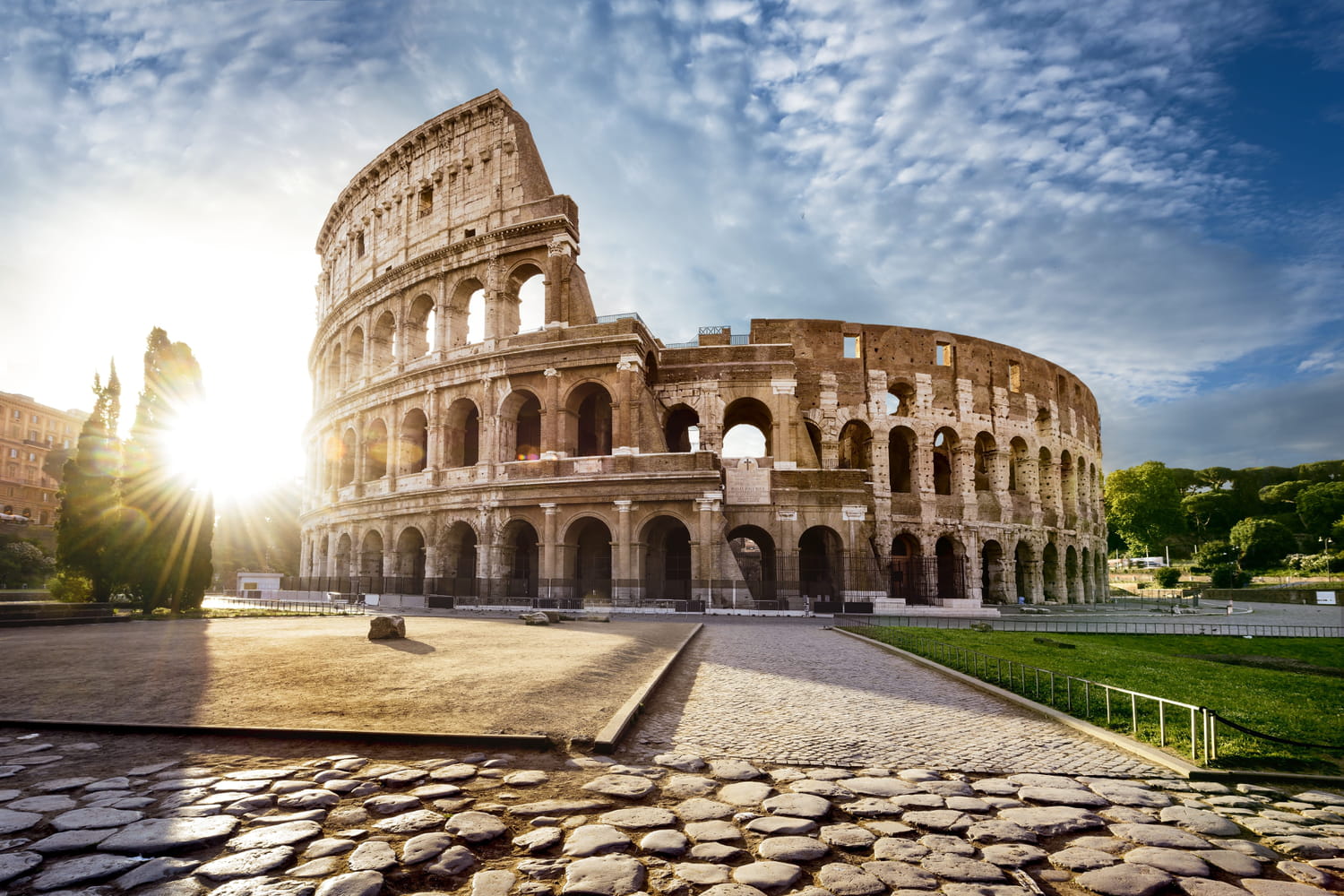
Causes de la chute de l'Empire romain La Nef
Un tableau complet de l'Empire romain d'Orient, à travers ses spécificités politiques, économiques, militaires, religieuses et intellectuelles. Au carrefour de l'Europe et de l'Asie, et affirmant un exceptionnel esprit d'adaptation aux nouvelles conditions stratégiques par des réformes permanentes, Byzance a influencé aussi bien ses voisins que ses héritiers.

Empire Romain d'Orient
Thracia or Thrace ( Ancient Greek: Θρᾴκη, romanized : Thrakē) is the ancient name given to the southeastern Balkan region, the land inhabited by the Thracians. Thrace was ruled by the Odrysian kingdom during the Classical and Hellenistic eras, and briefly by the Greek Diadochi ruler Lysimachus, but became a client state of the late Roman.

Byzance et l'Europe carolingienne Ma classe mobile
395 : à la mort de Théodose I er, l'Empire romain est partagé en deux parties : l'Empire romain d'Occident et l'Empire romain d'Orient (en grec Βασιλεία Ρωμαίων / Basileía Rômaíôn), dit Empire byzantin par Hieronymus Wolf, qui durera jusqu'au XV e siècle. Sa capitale est Constantinople. 395-408 : règne d'Arcadius
Carte De L\'empire Romain Carte
Le monde byzantin: L'Empire romain d'Orient, 330-641 Volume 1 of Le monde byzantin, Cécile Morrisson, ISBN 2130520081, 9782130520085 Nouvelle Clio (Presses universitaires de France, Paris).: Histoire et ses problèmes, ISSN 0768-2379 Nouvelle Clio, ISSN 0768-2379

Épinglé sur Antiquité
The term Roman Orient may refer to: Diocese of the Orient, an administrative diocese in eastern regions of the Roman Empire. Prefecture of the Orient, a praetorian prefecture in eastern regions of the Roman Empire. in general, eastern regions of the Roman Empire.

Chapitre 1 Histoire L’empire byzantin et l’empire carolingien la classe d'Histoire, Géo et
Ancient Orient of the Roman Empire and its ecclesiastical order after the Council of Chalcedon, 451. The Orient is a term referring to the East in relation to Europe, traditionally comprising anything belonging to the Eastern world.It is the antonym of the term Occident, which refers to the Western world.In English, it is largely a metonym for, and coterminous with, the continent of Asia.

L'empire romain au II siècle après JC r/geographie
Tome 1: L'Empire romain d'Orient (330-641) - Cécile Morrisson - Google Books. Ce premier volume est consacré à la période fondatrice, de l'inauguration de la capitale de Constantin sur le site de l'antique Byzance en 330 aux débuts de la conquête arabe au milieu du VIIe siècle qui détermine les limites territoriales réduites de l.

L'EMPIRE CHRÉTIEN 1ère partie QU'ESTCE QUE "L'EMPIRE BYZANTIN"
Un tableau complet de l'Empire romain d'Orient, a travers ses specificites politiques, economiques, militaires, religieuses et intellectuelles. Au carrefour de l'Europe et de l'Asie, et affirmant un exceptionnel esprit d'adaptation aux nouvelles conditions strategiques par des reformes permanentes, Byzance a influence aussi bien ses voisins que ses heritiers.

De l’Empire Romain aux empires chrétiens d’Orient et d’Occident (IVème et IXème siècles) YouTube
An Historical Map of the Roman Empire and the Barbarous Nations. Philadelphia: M. Carey and Son, 1820; from. The Roma Empire at its Greatest Extent - Palestine or Holy Land. Boston: Hilliard, Gray, Little, and Wilkins, 1826; from An Atlas accompanying Worcester's. Tableau De La Transmigration Des Barbares tracé à larges traits; Route qu'ils.

Cours de Histoiregéographie 6e L'Empire byzantin
L'Empire romain d'Orient poursuivit son existence sous la forme de l'Empire byzantin jusqu'en 1453. Malgré son appellation d'Empire romain, il était bien loin de la réalité antique et n'avait d'empire que le nom. Héritage de l'Empire romain.

Chute de l'Empire romain d'occident en 476 histoire, causes et conséquences
At its greatest extent, the empire ruled by Rome reached around the Mediterranean Sea and stretched from northern England to Nubia, from the Atlantic to Mesopotamia. Roman rule united this vast and varied territory, and Roman administration integrated it economically and socially. A traveler making a tour of the several provinces around 212 A.D. (when citizenship was extended to all free-born.

Roman Empire with provinces in 210 AD r/MapPorn
Empire romain d'Orient Empire byzantin Empire romain d'Orient (la) Imperium Romanum (Pars Orientalis) (grc) Βασιλεία Ῥωμαίων / Basileía Rhômaíôn 395 / 610 - 1204 1261 - 1453 Bannière « tétragrammatique » des Paléologues . Aigle bicéphale , insigne impérial des Paléologues (d'après une fresque du XIV e siècle). L'Empire byzantin à son extension maximale en.

Partition of the Roman Empire in 395 AD Division de l'Empire romain — Wikipédia Empire
La fin cataclysmique de l'Empire romain en Occident a eu tendance à masquer les caractéristiques sous-jacentes de la continuité. La carte de l'Europe en l'an 500 aurait été méconnaissable pour quiconque aurait vécu cent ans plus tôt. La ligne de démarcation solide qui séparait la civilisation romaine de ce qui avait été perçu comme la "barbarie" avait disparu.

Épinglé sur Antiquité
Semantic Scholar extracted view of "L'Empire romain d'Orient, 330-641" by C. Morrisson et al.

L'Empire byzantin, conservation de l'Empire romain Seconde Histoire myMaxicours
Avec sa capitale construite sur la ville antique de Byzance, l' Empire byzantin était le descendant direct de l' Empire romain d'Orient . Il dura près de mille ans, jusqu'à la prise de Constantinople par les Turcs en 1453. Après la chute de Rome en 476, une rupture majeure dans l'histoire romaine, il est admis par les historiens que.

Carte chute de l'Empire romain lhistoire.fr Cartographie Pinterest
The Byzantine Empire, also referred to as the Eastern Roman Empire, was the continuation of the Roman Empire centered in Constantinople during Late Antiquity and the Middle Ages.The eastern half of the Empire survived the conditions that caused the fall of the West in the 5th century AD, and continued to exist until the fall of Constantinople to the Ottoman Empire in 1453.